
One of the lower-key awesome aspects of the Insidious series is its overall coherence. These movies don’t contradict each other, and they’ve got a neat core saga with the Lambert family and the ever-haunted Elise. Insidious: The Red Door, the fifth movie in this franchise, proudly upholds that commitment to the big picture. If you’re eager to understand where the story goes, we’ve broken down what happens during the ending of Insidious: The Red Door, including the after-credits scene.
Warning: This article contains major spoilers for Insidious: The Red Door, including a detailed description of its ending.
What happens in Insidious: The Red Door?
The Red Door picks up a decade after the events of Insidious Chapter 2–the third and fourth movies were prequels, and they aren’t being disregarded or anything like that. During Chapter 2, a possessed Josh Lambert (Patrick Wilson) chased his family around the house with a hammer and tried to kill them, but young Dalton (Ty Simpkins) ventured into the spirit realm that they call The Further, found Josh’s spirit, and brought him back to his body. Both of them were then hypnotized so they would forget all this bad stuff and hopefully not get into another mess like this.
But unfortunately for Josh and Dalton, the powers-that-be in our world decided to make a new Insidious film about them, and so they got into another mess like that one.
Beginning with the death of Lorraine, Josh’s mom, Josh and Dalton experience the gradual return of these ghostly creatures as they slowly start to remember what happened to them. Their journeys largely occur separately, with Dalton at college across the country.
Dalton’s subconscious is unlocked through art. At the urging of his renowned art professor, he delves into his subconscious and paints what he finds there: a creepy red door. We know this door–that’s where all the creepy ghoulies in the other movies came from. Dalton may have forgotten the Red Door, but the Red Door didn’t forget him. When he stares at the painting too hard, it seems to have a hypnotic effect that knocks him out and sends him into the Further. And as we learned in the previous films, the more time he spends in that world, the more riled up the ghosts are going to be about it.
Josh’s story, meanwhile, takes a major turn when he’s at his recently deceased mom’s house doing memory exercises to try to pierce the brain fog he’s suffered from ever since the second movie. While he’s there, he meets a new ghost who looks like he walked out of the 1970s. And it turns out that’s exactly what this ghost did–this is Josh’s dad, a man named Ben Burton, who killed himself in a psych ward in 1978 because he had this exact same ghost problem. This is big news, because neither Josh nor the audience knew anything about his dad before this film. It also provides a thematic parallel to Josh’s own troubled relationship with Dalton.
Back at college, Dalton’s painting of the Red Door progresses as his subconscious unlocks his memories. Eventually, he’s added a pretty upsetting image of his father in front of the door, angrily wielding a hammer. The more the painting develops, and the more time Dalton spends studying it, the more the lines between reality and the Further blur–ghosts emerge into the real world, as before, and Dalton is even able to physically pull the hammer out of the painting. But his forays into the Further eventually go wrong, and he’s trapped by the returned Bride in Black, who then possesses his body.
As this plays out, Josh pays a visit to his ex-wife Renai (Rose Byrne) at the house they lived in during the events of the second movie, tells her all the stuff that he’s been learning about, and demands to know what it is that he’s forgotten–and she finally spills the beans. Realizing Dalton has to be in major trouble at this point (Josh had seen the painting before and finally connected all the dots), he ventures into the Further to see if he can get a handle on all this madness.
During his search for Dalton, Josh discovers a fascinating property of the Further: It exists outside of time, and so he actually encounters his past self saving Dalton in the first movie. (It’s a wrinkle they should do more with, honestly.)
Josh manages to free Dalton’s spirit, and they escape together through the Red Door–but Josh has to hold it shut while Dalton runs. Back in his body, Dalton makes the only move he can: He paints it black. The painting, that is: He covers the red door with black paint, and this turns the door black in the Further as well, seemingly sealing it shut. But all is not well–Josh dies in the Further while holding the door, his physical body in the real world apparently following suit. Yes, that makes him the Hodor of Insidious.
Of course, dying while you’re in a spirit world isn’t as straightforward as dying the normal way. In death, Josh explores a new section of this ethereal realm, and he once again encounters his father. This is a positive, healing encounter, andafterward, Josh is able to return to his body and resume living.
Dalton, meanwhile, declares to his pal Chris that the solution is the opposite of what his family tried before: They have to remember the bad stuff, because it turns out that forgetting is pretty freakin’ dangerous.
The film is capped off with a scene where Josh meets the ghost of Elise, though he hasn’t regained his memories of her, and so he doesn’t realize that she’s a dead person. Elise tells him that he and Dalton will have good lives and be happy. Which I guess leaves us with a happily ever after.
Or does it?
Does Insidious: The Red Door have a post-credits scene?
It’s not any kind of big scene or anything like that, but there’s a very small stinger after the credits, where we see the Newly Black Door light up once again. Looks like, ahem, the door isn’t closed on the Insidious franchise just yet.
The products discussed here were independently chosen by our editors.
GameSpot may get a share of the revenue if you buy anything featured on our site.























